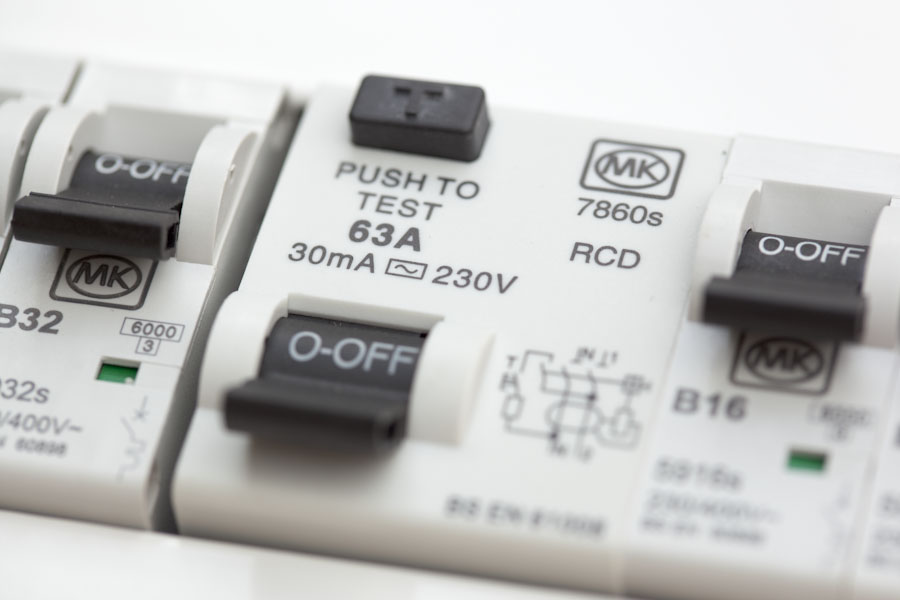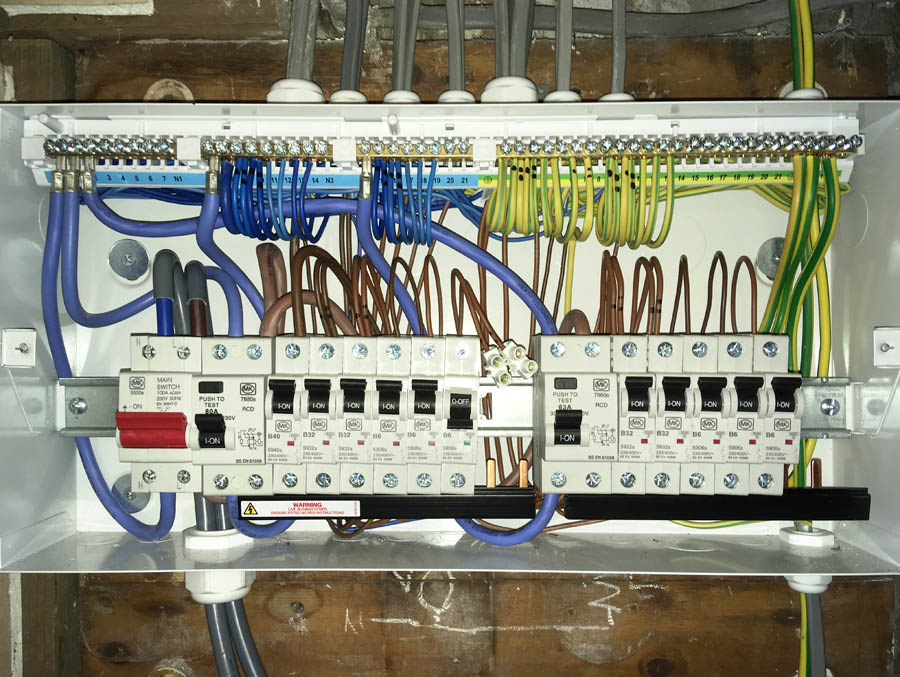When is a fuse board upgrade necessary?
If you plan to have electrical work done in your home and the fuse board is out-of-date, it will usually need replacing with a modern consumer unit. In most cases additions or alterations to an electrical installation will require a 30mA RCD for additional protection – most older boards do not have this.
Replacing a fuse board
Upgrading from an old fuse board to a modern consumer unit is beneficial even if no other electrical work is planned. RCDs are life saving devices, greatly reducing the risk of fire and electric shocks. Old rewireable fuses, and other outdated protective devices, are not as sensitive. Having an old fuse board upgraded provides peace of mind, as you can be sure that your home conforms to the most up-to-date safety standards.
RCD protection
An RCD, or Residual Current Device, switches off the electricity supply in the event of an earth fault. It offers a level of protection which ordinary fuses or circuits breakers cannot provide.
 An RCD monitors the electric current flowing through the circuits it is used to protect. If it detects electricity flowing through an unintended path, such as through a person who has touched a live part, it will switch off immediately and greatly reduce the risk of death or serious injury. RCDs have been shown to be around 97% reliable and, when installed in a consumer unit, will protect all circuits and any appliances connected to those circuits.
An RCD monitors the electric current flowing through the circuits it is used to protect. If it detects electricity flowing through an unintended path, such as through a person who has touched a live part, it will switch off immediately and greatly reduce the risk of death or serious injury. RCDs have been shown to be around 97% reliable and, when installed in a consumer unit, will protect all circuits and any appliances connected to those circuits.
18th Edition Wiring Regulations
Since the introduction of the 17th edition wiring regulations in 2008 nearly all circuits are required to have 30mA RCD protection. Below are some examples of where RCD protection is required in a domestic setting:
- 411.3.3 (i) – for socket outlets with a rated current not exceeding 32A
- 411.3.4 – for lighting circuits
- 701.411.3.3 – for all low voltage circuits serving locations containing a bath or shower
- 701.411.3.3 – for all low voltage circuits passing through zones 1 and 2 of locations containing a bath or shower but not serving equipment within the location
- 522.6.202 – for cables without earthed metallic covering installed in walls or partitions at a depth of less than 50mm and not protected by earthed steel conduit, earthed trunking or earthed ducting.
What is involved?
Before the fuse board is changed, preliminary inspection and testing is carried out on all circuits to ensure that no faults or examples of non-compliance are present. This includes, but is not limited to, the following:
- checking for damaged sockets, light fittings and accessories
- presence and/or suitability of main protective bonding (earth) to water and gas
suitability of earthing conductor and meter tails - testing end to end continuity of conductors on ring circuit(s)
- testing continuity of earth on all circuits
- insulation resistance testing on all circuits. Initially this would be checking for earth faults not detected by existing protective devices so that no nuisance tripping occurs when the new unit is fitted. Full insulation resistance tests will be carried out after the new unit is fitted
- Checking for grommets/correct sleeving in back boxes
Any faults or examples of non-compliance that arise during this procedure need to be addressed before any further work is carried out. Once any necessary remedial work is finished the new consumer unit can be fitted and a full series of testing can be carried out on all circuits.
Arc Electrical make every effort to ensure that the process goes as smoothly as possible – see our Customer Promise.
Upon completion of the work all appropriate certification and notification will be taken care of by us.
3rd amendment changes to consumer units
The 3rd amendment to BS7671 17th edition wiring regulations was introduced on 1st January 2015. It states that all new consumer units installed within a domestic premises are to be constructed from non-combustible materials.
421.1.201 – Within domestic (household) premises, consumer units and similar switchgear assemblies shall comply with BS EN 61439-3 and shall:
- (I) have their enclosure manufactured from non-combustible material, or
- (II) be enclosed in a cabinet or enclosure constructed of non-combustible material and complying with Regulation 132.2.
A recent report by the London Fire Brigade records five house fires every week involving plastic consumer units. The majority of these incidents were the result of poor electrical connections inside the consumer units. Because the unit casings were moulded plastic, the spread of fire was unavoidable.
In addition to the changes outlined above, the Electrical Installation Certificate inspection checklist now includes a section dedicated to consumer units. Contractors are now obliged to check that all consumer units worked on, whether existing or newly installed, have secure wiring and tight connections.


